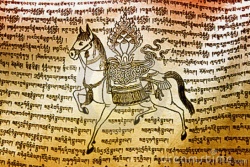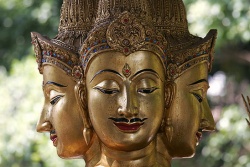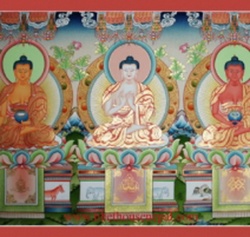Shamatha in the Indian Buddhist Tradition
By B. Alan Wallace
As a result of the genocide perpetrated against Buddhist cultures throughout Asia during the twentieth century at the hands of various communist regimes, all waving the ideological banner of scientific materialism, the very survival of Mahayana Buddhism in particular has been imperiled. Thus, for many of its followers, the preservation of the vitality of the Mahayana tradition in the modern world is a highest priority. There are various ways of preserving this tradition. Outwardly, the creation of images of the Buddha, translations and publications of Buddhist teachings, and the building of stupas are ways of preserving representations of the Buddha’s body, speech and mind. All of such efforts are expressions of sincere devotion. On one occasion, Dromtönpa, the principal Tibetan disciple of the great Indian Buddhist master Atisha, encountered a man engaging in various devotional practices. He responded, “It is very good to apply yourself to devotional practices, but it is even better to practice Dharma.”
To preserve their tradition, many Buddhists nowadays place their highest priority on teaching and studying Buddhist texts. When Dromtönpa next met with this same practitioner, he found him studiously applying himself to learning Buddhist scriptures, to which he responded, “It is very good to study texts, but it is even better to practice Dharma.
In order to preserve the true meaning of Buddhism, many sincere practitioners today apply themselves to months or even years of meditation, practicing mindfulness many hours a day, or engaging in three-year retreats in which they practice a wide variety of Vajrayana meditations. When Dromtönpa for a third time came across the above practitioner, he found him immersed in meditation, to which he replied, “It is very good to practice meditation, but it is even better to practice Dharma.” When the meditator asked him how to do this, he responded, “Give up attachment to this life and let your mind become Dharma.”
The essential way to let one’s mind become Dharma is to realize uncontrived bodhichitta and thereby reach the initial stage of the Mahayana path of accumulation, the first of the five paths leading to perfect enlightenment. Bodhichitta becomes irreversible when it is supported with the insights gained from the four close applications of mindfulness, thus transforming “earth-like bodhichitta” into “gold-like bodhichitta.” With a foundation in shamatha, bodhichitta and insight, Vajrayana practice may indeed lead to the realization of perfect enlightenment in one lifetime. But without such a basis in mental stability, compassion and wisdom, talk of buddhahood in this or any other lifetime is nothing more than propaganda.
To realize authentic bodhichitta and going on to become a bodhisattva, many of the greatest scholars in the Buddhist tradition have taught that the mind must first be made thoroughly serviceable for spiritual practice by achieving shamatha, specifically access to the first dhyana (meditative stabilization). Although there isn’t full consensus on this point, all agree that a mind heavily prone to the attentional imbalances of excitation and laxity is unfit to realize the sublime states of bodhichitta and vipashyana (contemplative insight). So at least the partial development of shamatha is essential for developing both.
The fundamental structure of Buddhist practice, common to all schools of Buddhism, consists of the three sequential phases of ethics, samadhi and wisdom. Within the context of these three “higher trainings,” samadhi refers not only to the development of single-pointed attention, but also to other aspects of mental development, including the four immeasurables (loving kindness, compassion, empathetic joy, and equanimity), renunciation, and within the Mahayana context, bodhichitta.
Among all the Buddha’s teachings recorded in the Pali canon, the shamatha practice most commonly emphasized is mindfulness of the breath, particularly for people whose minds are heavily agitated by involuntary thoughts. Compared to Indians living at the time of the Buddha or nomadic Tibetans living today, most of us can greatly benefit from such practice, which is specifically designed for people like us! The Buddha said of this practice, “Just as in the last month of the hot season, when a mass of dust and dirt has swirled up and a great rain cloud out of season disperses it and quells it on the spot, so too concentration by mindfulness of the breath, when developed and cultivated, is peaceful and sublime, an ambrosial dwelling, and it disperses and quells on the spot unwholesome states whenever they arise.”[1] The very nature of such practice helps not only to bring calm and joy to the mind, but it also helps to bolster our “psychological immune system,” making the mind less vulnerable to mental afflictions.
More generally, the cultivation of shamatha leads to freedom from the five obscurations of (1) laxity and dullness, (2) uncertainty, (3) malice, (4) excitation and guilt, and (5) sensual craving. The Buddha declared, “So long as these five obscurations are not abandoned one considers himself as indebted, sick, in bonds, enslaved and lost in a desert track.”[2] Indian Buddhist contemplatives discovered that these five obscurations are counteracted by the five factors of meditative stabilization. Specifically, (1) coarse examination counteracts laxity and dullness, (2) precise investigation counteracts uncertainty, (3) well-being counteracts malice, (4) bliss counteracts excitation and guilt, and (5) single-pointed attention counteracts sensual craving. It is fascinating to note that such non-discursive practice can be effective in overcoming sensual craving and malice, thereby serving as a basis for developing renunciation and compassion.
Shamatha practice that is not motivated by renunciation and bodhichitta may result in nothing more than a temporary alleviation of stress and agitation, and may even lead to self-centered complacency and unfortunate rebirths. With an authentic motivation, shamatha may actually enhance one’s renunciation and bodhichitta, kindling great inspiration for spiritual practice. Well motivated practice that is focused on external activities of the body and speech, including prostrations, circumambulations, and recitation of mantras and liturgies will have little benefit if the mind is distracted. As the Indian Bodhisattva Shantideva wrote, “The Omniscient One stated that all recitations and austerities, even though performed for a long time, are actually useless if the mind is on something else or is dull.”[3]
The structure of the Mahayana path consists of the six perfections of generosity, ethics, patience, enthusiasm, meditative stabilization and wisdom. The practice of shamatha is included in the cultivation of meditative stabilization (dhyana), and it is based on the prior development of the first four perfections. This highlights the importance of cultivating an ethical basis for practice and wholesome states of mind before seeking to achieve single-pointed concentration.
Roughly 1500 years after the time of the Buddha (563-483 BCE), the great Indian Buddhist master Atisha (980-1054) composed the first “lam-rim,” or teachings on the stages of the path, specifically for Tibetans. This structure, which was subsequently adopted by all schools of Tibetan Buddhism, begins with guru yoga and culminates in the practice of vipashyana. For traditional Tibetans, raised in a Buddhist culture, with deep faith, and a sound understanding of Buddhism, guru yoga may well be practiced at the outset of the path for the sake of the many blessings such authentic practice brings. But in the modern secular world, an initial focus on guru yoga, especially with the emphasis on the perfect qualities of the guru, can lead to many problems, a point that has been discussed frequently by His Holiness the Dalai Lama. For people with little faith or understanding, or who are new to Buddhism, it may be best initially to focus upon one’s guru simply as a representative, or emissary, of the Buddha. As one ventures in Mahayana practice, one may view one’s guru as if he or she were a buddha. Finally, on the basis of deep faith and understanding of the teachings on the buddha-nature and emptiness, one may focus on the Vajrayana practice of viewing one’s guru as an actual buddha, while simultaneously developing divine pride and pure perception of all phenomena.
While there are many methods for developing shamatha, each with its special advantages, two methods are particularly emphasized in the Mahamudra tradition because of their great advantages for fathoming the nature of consciousness. The eleventh-century Indian Mahasiddhi Maitripa, who taught Marpa, the Tibetan translator and founder of the Kagyü lineage, describes the first method of focusing on thoughts as follows:
“In relation to the excessive proliferation of conceptualization, including afflictions such as the five poisons or the three poisons, thoughts that revolve in subject-object duality, thoughts such as those of the ten virtues, the six perfections or the ten perfections – whatever wholesome and unwholesome thoughts arise – steadily and non-conceptually observe their nature. By so doing, they are calmed in non-grasping; clear and empty awareness vividly arises, without grasping; and it arises in the nature of self-liberation, in which it recognizes itself. Again, direct the attention to whatever thoughts arise, and without acceptance or rejection, let it recognize its own nature. In this way implement the practical instructions on transforming ideation into the path.”[4]
Here are his instructions on the second method which focuses on the absence of thoughts:
“With the body possessing the seven attributes of Vairochana, sit upon a soft cushion in a solitary, darkened room. Vacantly direct the eyes into the intervening vacuity in front of you. See that the three conceptualizations of the past, future and present, as well as wholesome, unwholesome and ethically neutral thoughts, together with all the causes, assemblies and dissolutions of thoughts of the three times are completely cut off. Bring no thoughts to mind. Let the mind, like a cloudless sky, be clear, empty and evenly devoid of grasping; and settle it in utter vacuity. By doing so, the shamatha quiescence of joy, clarity, and non-conceptuality arises. Examine whether or not this entails attachment, hatred, clinging, grasping, laxity or excitation, and recognize the difference between virtues and vices.”[5]
There are two traditional approaches to the path. One entails first gaining a thorough understanding of Buddhist doctrine, including the view of emptiness, and on that basis devoting oneself to meditation. According to this tradition, one practices shamatha only after studying Maitreya’s treatise revealed to Asanga, the The Ornament for Clear Realization, and one practices vipashyana only after a careful study of Chandrakirti’s Supplement to the “Middle Way.” According to the second tradition, one may seek the view of emptiness on the basis of first achieving shamatha. In his text The Highway of the Jinas: A Root Text on the Precious Geluk-Kagyü Mahamudra Tradition, Panchen Lozang Chökyi Gyaltsen, tutor to the Fifth Dalai Lama, exemplifies the latter tradition when he gives the following quintessential shamatha teachings, in which he synthesizes the two methods cited above by Maitripa:[6]
“Of the two approaches of seeking to meditate on the basis of the view and seeking the view on the basis of meditation, the following accords with the latter approach. On a comfortable cushion for the cultivation of meditative stabilization, assume the sevenfold posture and with the nine-fold breathing clear out stale vital energies. Carefully distinguish between the radiant purity of awareness and its defilements, and with a pristinely virtuous mind begin by taking refuge and cultivating bodhichitta. Meditate on the profound path of guru yoga, and after making hundreds of heartfelt supplications, let the guru dissolve into yourself.
Do not modify the nature of evanescent appearances with thoughts such as hopes and fears, but rest for a while in unwavering meditative equipoise. This is not a state in which your attention is blanked out, as if you had fainted or fallen asleep. Rather, post the sentry of undistracted mindfulness and focus introspection on the movements of awareness. Focus closely on its nature of cognizance and luminosity, observing it nakedly. Whatever thoughts arise, recognize each one. Alternatively, like a participant in a duel, completely cut off any thoughts that arise; when there is stillness after they are banished, relax loosely, but without losing mindfulness. As it is said, ‘Focus closely and loosely relax – it is there that the mind is settled.’ Relax without wandering, as the saying goes, ‘When the mind that is tangled up in busyness loosens up, it undoubtedly frees itself.’
Whenever thoughts arise, if their nature is observed, they naturally disappear and a clear vacuity arises. Likewise, if the mind is examined when it is still, a vivid, unobscured, luminous vacuity is perceived, and this is known as ‘the fusion of stillness and motion.’ Whatever thoughts arise, do not block them, but recognizing their movements, focus on their nature – like a caged bird on a ship. Sustain your awareness as in the saying, ‘Like a raven that flies from a ship, circles around, and alights aboard once again.’
The nature of meditative equipoise is not obscured by anything, but is limpid and clear. Not established as anything physical, it is a clear vacuity like space. Allowing anything to arise, it is vividly awake. Such is the nature of the mind. This is superbly witnessed with direct perception, yet it cannot be grasped as ‘this’ or demonstrated with words. ‘Whatever arises, rest loosely, without grasping:’ nowadays, for the most part, contemplatives of Tibet uniformly proclaim this as practical advice for achieving enlightenment. However, I, Chökyi Gyaltsen, declare this to be an exceptionally skillful method for novices to achieve mental stability and to identify the relative nature of the mind.”
The relative nature of the mind is sheer luminosity and cognizance, which are the defining characteristics of consciousness. The Buddha also referred to this as the sign (nimitta) of the mind. He declared that if one cultivates the four close applications of mindfulness without the mind being concentrated and without having abandoned the impurities, one will not apprehend this essential nature of the mind.[7] These teachings on shamatha provide a basis not only for the cultivation of the four immeasurables and bodhichitta, but also for the cultivation of insight through the fundamental practices of four close applications of mindfulness.
Alan Wallace, Ph.D. is a dynamic lecturer, progressive scholar and one of the most prolific writers and translators of Tibetan Buddhism in the West. He continually seeks innovative ways to integrate Buddhist contemplative practices with Western science to advance the study of the mind.
1Samyutta Nikaya V, 321-2.
2Sāmaññaphala Sutta in Dīgha Nikāya I 73.
3Shantideva, A Guide to the Bodhisattva Way of Life. Vesna A. Wallace & B. Alan Wallace (trans.) Ithaca, NY: Snow Lion Publications, 1997, V: 16.
4Karma Chagmé, A Spacious Path to Freedom: Practical Instructions on the Union of Mahamudra and Atiyoga, Commentary by Gyatrul Rinpoche, trans. B. Alan Wallace (Ithaca, NY: Snow Lion Publications, 2009), 80.
5Ibid.
6Collected Works of Paṇchen blo bzang chos kyi rgyal mtshan, New Delhi: Mongolian Lama Gurudeva, 1973, Vol. IV, 84 – 86. Translation by B. Alan Wallace.
7Samyutta Nikaya V, 150-52







